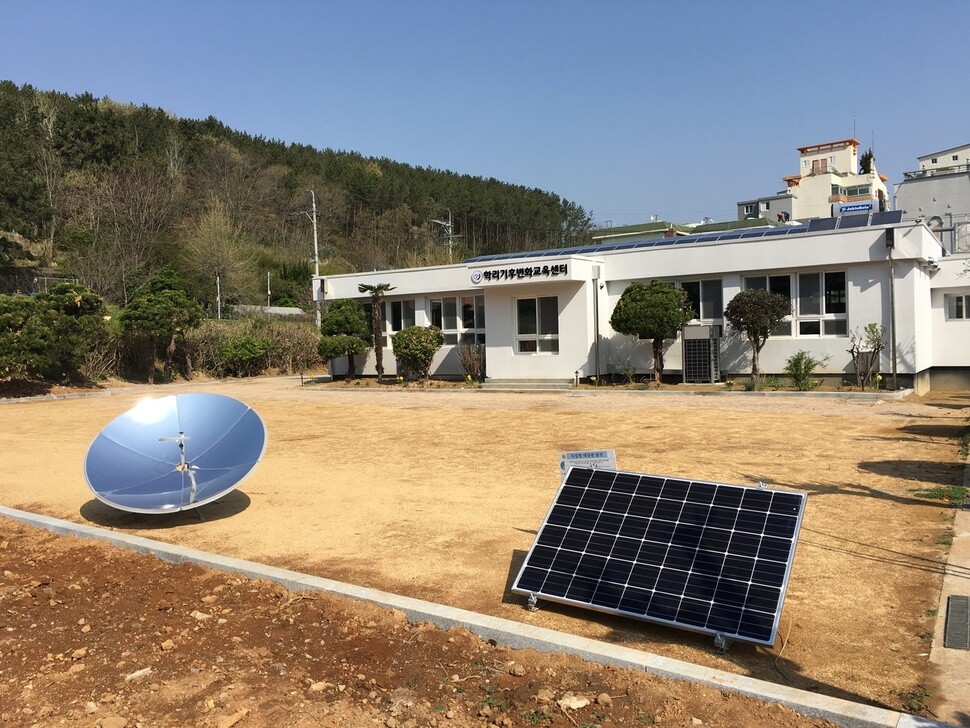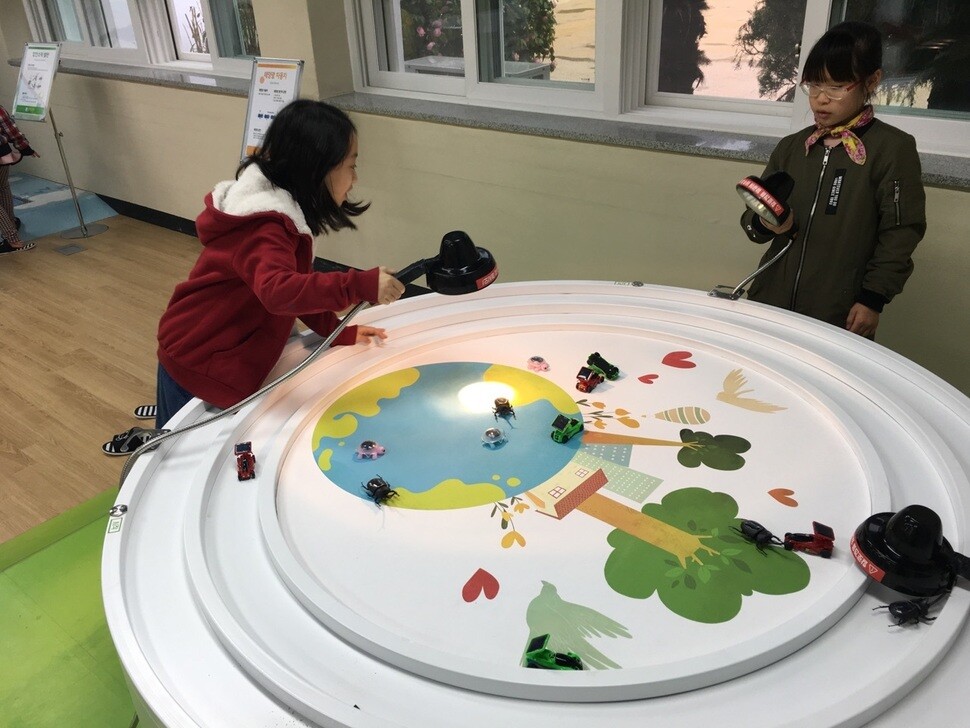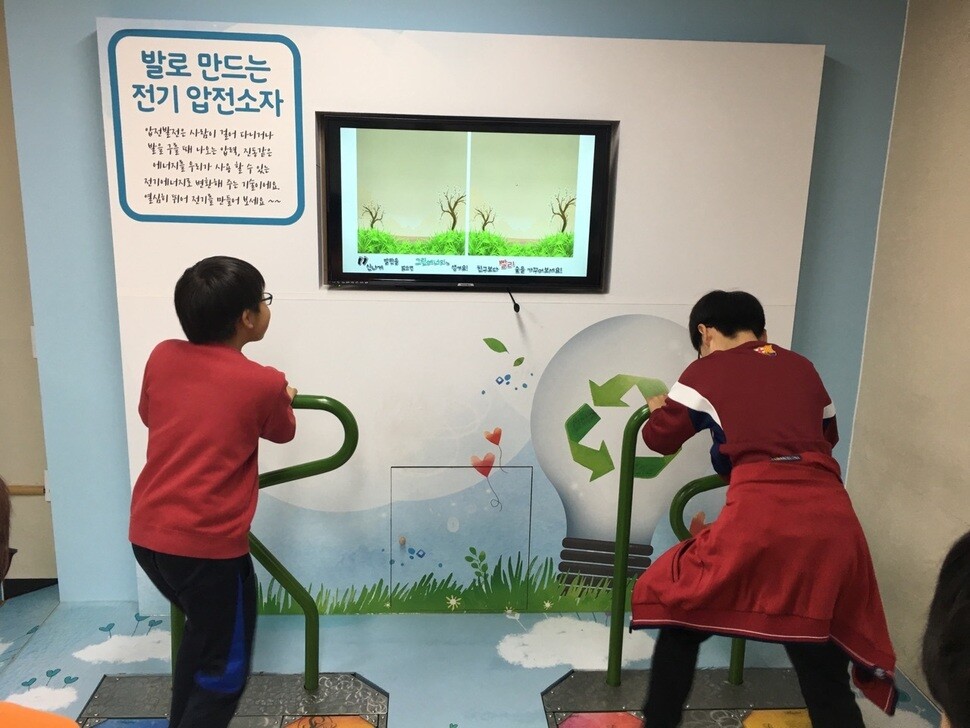hankyoreh
Links to other country sites 다른 나라 사이트 링크
Shut down school near nuke plants becomes place to experience renewable energy

As the student began forcefully pedaling the bicycle in the first-floor hallway of the former Hangni branch school of Ilgwang Elementary School in Busan on Apr. 5, the blender went into motion. Nineteen on-looking Ilgwang fourth graders gasped in astonishment. They nodded along as it was explained to them that the kinetic energy from the bicycle was being converted into electrical energy to power the blender.
The Hangni branch school was shut down in 2006 after the number of students dropped so low that both first and second graders were left sharing the same classroom. After debating what to do with the building, the Busan Metropolitan Office of Education (BMOE) decided to turn it into a center aimed at sharing experiences and instilling lifestyle habits of using alternative and renewable energy sources like solar and wind power rather than relying on the fossil fuels, which are a major cause of global warming.

Another factor was the branch school‘s location - about 8 km from the Kori Nuclear Power Plant complex, home of the world’s densest concentration of nuclear power plants. The decision was that with South Korea’s dependence on nuclear power among total energy consumption growing by the day, it might be more effective for the future generation of elementary, middle, and high school students to visit a school nearby the complex and experience for themselves how they could live full lives without relying on nuclear power.
On Apr. 21, the building is set to reopen as the Hangni Climate Change Education Center. The opening comes 10 years after the branch school was closed down. One feature of the center is that the building runs entirely on solar energy. Indoor energy is produced with a solar energy generator on the structure’s roof, while 15 kilowatts of energy produced by a solar heat generator are used for water heating. The center also has solar-powered streetlights. The building was remodeled with a carbon-reducing environmentally friendly structure using recycled resources. It’s a “passive house” designed to prevent indoor energy from leaking outside. The over 500 million won (US$438,000) in project costs were paid by the BMOE from a 2015 metropolitan and provincial office of education assessment prize fund awarded by the Ministry of Education.

The center has one lecture hall and one activity room. The activity room includes a wind power generator where three-winged dynamos operate in sequence when a handle is turned; a solar-powered toy car equipped with a solar panel that allows it to move when a flashlight is shone on it; a piezoelectric unit generating an electric current that intensifies with the pressure from running; and a bicycle generator with an LED that lights up when the pedals are turned. There’s also a workshop where visitors can make their own soap, natural cosmetics, and bicycle generators. The athletic field has a solar cell-powered cooking device for visitors to cook fish jerky and pop popcorn.
The center runs from 9 am to 6 pm from Monday to Friday. It offers instruction on ways of saving energy and protecting the environment in daily life in connection with issues such as global warming. Its 16 programs last two to three hours each and are free to attend on a reservation basis. Due to size constraints, only 15 to 50 people each can be accommodated in mornings and afternoons.
By Kim Kwang-soo, Busan correspondent
Please direct questions or comments to [english@hani.co.kr]

Editorial・opinion
![[Column] Season 2 of special prosecutor probe may be coming to Korea soon [Column] Season 2 of special prosecutor probe may be coming to Korea soon](https://flexible.img.hani.co.kr/flexible/normal/500/300/imgdb/original/2024/0426/3317141030699447.jpg) [Column] Season 2 of special prosecutor probe may be coming to Korea soon
[Column] Season 2 of special prosecutor probe may be coming to Korea soon![[Column] Park Geun-hye déjà vu in Yoon Suk-yeol [Column] Park Geun-hye déjà vu in Yoon Suk-yeol](https://flexible.img.hani.co.kr/flexible/normal/500/300/imgdb/original/2024/0424/651713945113788.jpg) [Column] Park Geun-hye déjà vu in Yoon Suk-yeol
[Column] Park Geun-hye déjà vu in Yoon Suk-yeol- [Editorial] New weight of N. Korea’s nuclear threats makes dialogue all the more urgent
- [Guest essay] The real reason Korea’s new right wants to dub Rhee a founding father
- [Column] ‘Choson’: Is it time we start referring to N. Korea in its own terms?
- [Editorial] Japan’s rewriting of history with Korea has gone too far
- [Column] The president’s questionable capacity for dialogue
- [Column] Are chaebol firms just pizza pies for families to divvy up as they please?
- [Column] Has Korea, too, crossed the Rubicon on China?
- [Correspondent’s column] In Japan’s alliance with US, echoes of its past alliances with UK
Most viewed articles
- 1[Column] Season 2 of special prosecutor probe may be coming to Korea soon
- 2‘We must say no’: Seoul defense chief on Korean, USFK involvement in hypothetical Taiwan crisis
- 3Is N. Korea threatening to test nukes in response to possible new US-led sanctions body?
- 4Amnesty notes ‘erosion’ of freedom of expression in Korea in annual human rights report
- 5Division commander ordered troops to enter raging flood waters before Marine died, survivor says
- 6N. Korean delegation’s trip to Iran shows how Pyongyang is leveraging ties with Moscow
- 7[Editorial] Korea’s surprise Q1 growth requires objective assessment, not blind fanfare
- 8Is Japan about to snatch control of Line messenger from Korea’s Naver?
- 9No good, very bad game for Korea puts it out of Olympics for first time since 1988
- 10[Reportage] On US campuses, student risk arrest as they call for divestment from Israel